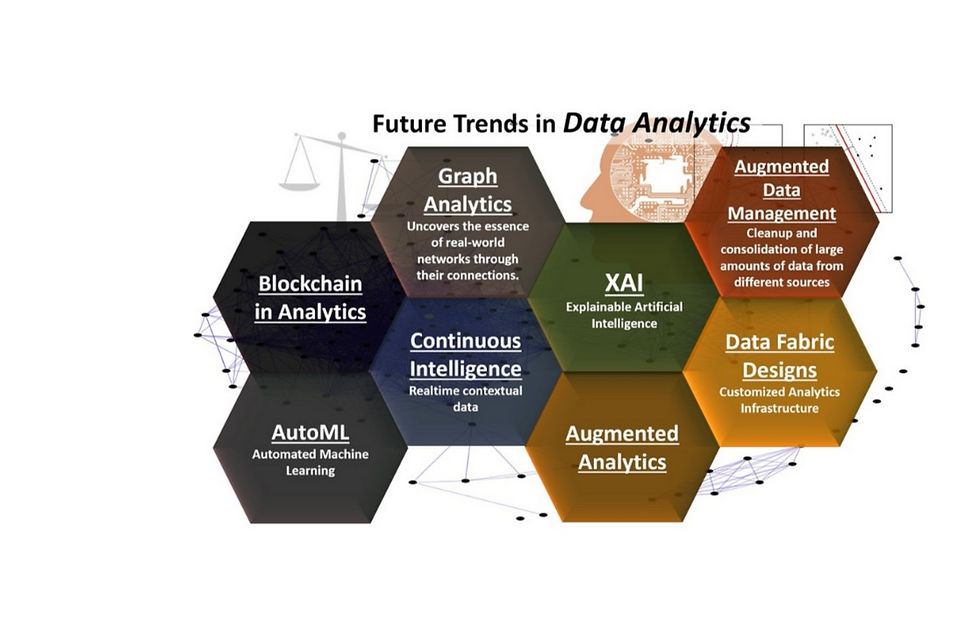The Future of Data Analytics: Emerging Trends and Technologies
- Pratham Chaudhry
- Jan 11, 2024
- 3 min read
In today's data-driven world, the landscape of data analytics is constantly evolving, driven by advancements in technology and the ever-increasing volume and complexity of data. As organizations strive to derive actionable insights from their data to gain a competitive edge, it's essential to stay ahead of emerging trends and technologies shaping the future of data analytics. In this blog post, we'll explore the exciting frontier of data analytics, delving into emerging trends and technologies that are revolutionizing the way we collect, analyze, and derive value from data.

1. Introduction to the Future of Data Analytics:- This section sets the context for the discussion by highlighting the ongoing evolution of data analytics and its significant impact on various industries. It introduces the theme of exploring emerging trends and technologies that are shaping the future of data analytics, creating opportunities for innovation and transformation.
2. Augmented Analytics:- Augmented analytics refers to the integration of artificial intelligence (AI) and machine learning (ML) technologies into analytics processes to enhance decision-making capabilities. This approach automates data preparation, analysis, and visualization tasks, enabling users to uncover insights more efficiently and accurately. Augmented analytics platforms leverage advanced algorithms to assist users in discovering patterns, trends, and anomalies in data, leading to faster and more informed decision-making.
3. Real-Time Analytics:- Real-time analytics involves processing and analyzing data as it is generated to derive timely insights and make immediate decisions. With the increasing velocity of data streams from various sources such as IoT devices, social media, and transactional systems, real-time analytics has become essential for businesses to respond quickly to changing conditions and seize opportunities. Technologies like in-memory computing and stream processing enable organizations to ingest, process, and analyze data in real-time, facilitating faster decision-making and improved operational efficiency.
4. AI and Machine Learning Integration:- AI and machine learning are revolutionizing data analytics by enabling more advanced predictive modeling, anomaly detection, natural language processing, and recommendation systems. Integrating AI and ML into analytics workflows enhances the accuracy and effectiveness of predictive models and enables automation of complex tasks. AI-driven analytics platforms can analyze large volumes of data, identify patterns and trends, and generate actionable insights, empowering organizations to make data-driven decisions with confidence.
5. Edge Analytics:- Edge analytics involves performing data analysis tasks closer to the data source or "edge" of the network, rather than in centralized data centers or cloud environments. This approach reduces latency, bandwidth usage, and dependency on cloud infrastructure, making it ideal for applications that require real-time or near-real-time insights. Edge analytics is particularly relevant in IoT deployments, where data is generated at distributed locations and needs to be processed and analyzed locally to enable quick responses and optimizations.
6. Data Democratization and Self-Service Analytics:- Data democratization aims to empower non-technical users within organizations to access, analyze, and derive insights from data independently. Self-service analytics platforms and tools provide intuitive interfaces and pre-built templates that enable business users to explore and visualize data without requiring technical expertise. By democratizing access to data and analytics capabilities, organizations can foster a data-driven culture and accelerate decision-making processes across all levels of the organization.
7. Ethical Data Usage and Governance:- As the volume and complexity of data continue to grow, ensuring ethical data usage and governance becomes increasingly important. Organizations must address ethical considerations such as data privacy, transparency, fairness, and bias mitigation to maintain trust and integrity in their data practices. Regulations like GDPR and CCPA impose requirements for data protection and privacy, requiring organizations to adopt transparent and ethical data practices to comply with legal and regulatory standards.
8. Blockchain and Data Security:- Blockchain technology has the potential to revolutionize data security and integrity by providing a decentralized and immutable ledger for recording transactions and data exchanges. In data analytics, blockchain can enhance data security, integrity, and provenance by ensuring tamper-proof records and transparent audit trails. Blockchain-based solutions enable secure and transparent data sharing, authentication, and verification, making them ideal for industries like healthcare, finance, and supply chain management where data security and trust are paramount.
9. Embracing the Future of Data Analytics:- The conclusion summarizes the key trends and technologies discussed in the blog post, emphasizing the importance of embracing the future of data analytics to drive innovation and competitive advantage. By staying abreast of emerging trends and technologies, organizations can harness the power of data analytics to unlock new opportunities, optimize operations, and deliver value to customers and stakeholders.







Comments